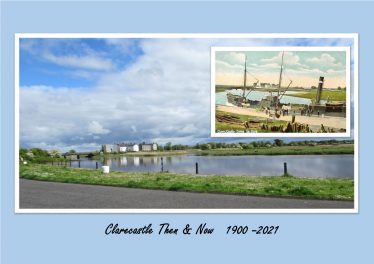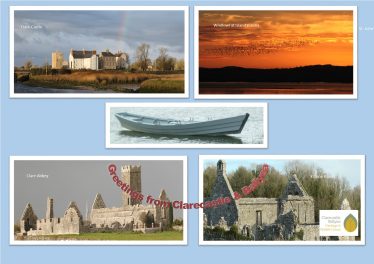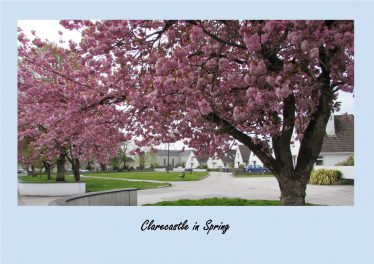Daoine agus Áit: Connecting Our Communities - iCan Project 2021


















HERITAGE POSTCARD FOR CLARECASTLE
We are delighted to announce our Clarecastle contribution to the iCan 2021 Heritage Postcard Project under the theme of ‘Daoine agus Áit: Connecting Our Communities’. The objective of the project is to draw on a shared history and heritage to connect people with their place, with their communities and with the diaspora. The chosen postcard will be printed and distributed in the community.
The drawing of Clare Castle by Robert O’Callaghan Newenham c.1826 was selected by Clarecastle & Ballyea Heritage & Wildlife Group as the image that best explains the origins of Clarecastle, with the Castle shown on an island in the river Fergus and the two crossings.
These physical features led to the original name of Cláir Átha Dá Caradh, recorded in the Annals of the Four Masters in 1270 AD – wooden planks fording the two weirs. The word Cláir is the key word, giving the name to the Clare Bridge, Clare Castle and the settlement that grew up around the crossings, the village of Clare. Clár or Clare has been reflected in the many names and spellings of Clarecastle down through the centuries, as indicated on the rear of the postcard. In 1570 the name of the village of Clare was chosen as the name of the county of Clare.
How County Clare got its name
Although Irish counties, including Clare, command the passionate loyalties of their inhabitants they are not of Irish origins at all, but were imposed on the country by foreign (Norman and later English] invaders. They were created in two phases, corresponding with the two most important periods of English expansion in Ireland, the thirteenth and sixteenth centuries. The process of shiring (or creating counties] commenced with the creation of Dublin before the 1190s and by 1300 Munster and Leinster had been divided into a series of counties. Each was ruled by a sheriff whose role combined those of governor, chief justice and general. However, the Gaelic Irish made a remarkable recovery in the fourteenth and fifteenth centuries, which resulted in the effective collapse of many of the counties created in the thirteenth century. The Tudor conquest (1534-1603) resulted in the second and most lasting wave of shiring in Ireland. One of the most significant years in this process was 1570, when a total of eight counties were created. Among these was Clare, the subject matter of this book, which had formerly been known as Thomond[i].
The English administration not only created County Clare but gave it the name ‘Clare.` lt is now agreed that ‘Clare’ is an anglicised version of clár, meaning a board or a plank, one of which was used as a bridge across the River Fergus near what is now the town of Clarecastle. This theory was expounded by the historian Fr Patrick White and has found widespread support from modern scholars[ii].
The Story of Clare and its People, Dr Matthew Potter and Dr John Treacy. Edited by Dr Joe Power, published by Clare County Council, 2020
[i] Matthew Potter, ‘Geographical Loyalty? Counties, Palatinates, Boroughs & Ridings’ in History Ireland, Vol. 20, No. 5 (September/October 2012), pp 24-27.
[ii] Patrick White, History of Clare and the Dalcassian Clans of Tipperary, Limerick and Galway (Dublin 1893) p130.
In arriving at the choice of image, the group considered other designs, which are shown below and organised a Design a Postcard Competition for 4th – 6th classes in Ballyea and Clarecastle schools. These 150 plus entries give us a wonderful insight into how our young people see their ‘Daoine agus Áit’ and will be exhibited during Heritage Week. The results can be seen at:




No Comments
Add a comment about this page